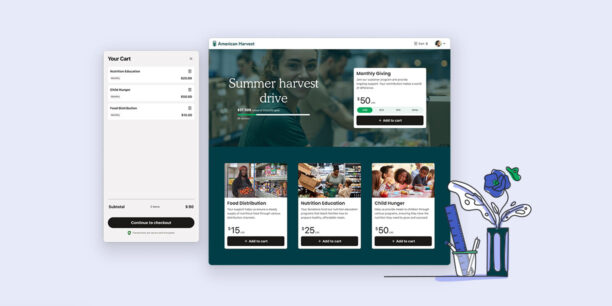5 Critical Steps to Navigate Fundraising in a Presidential Election Year

Request a Demo
Learn how top nonprofits use Classy to power their fundraising.
Fundraising during an election year presents unique challenges and opportunities for nonprofits. As the competition for donors’ attention and resources intensifies, it’s crucial to have a solid strategy to thrive despite the election buzz.
In Classy’s recent webinar with M+R, a public relations and communications agency for nonprofits, our teams discussed new strategies to succeed and stand out during the 2024 election season and beyond. Classy’s Michelle Hansen, Senior Manager of Customer Success, joined Gwen McGarry and Will Valverde for an insightful discussion that we dive into below.
Let’s explore five key tactics to fuel your fundraising success in 2024, discuss how to navigate the challenges, and identify ways to capitalize on the opportunities presented by the election. We’ll provide an actionable blueprint for you to tailor your fundraising efforts, drawing from historical trends and insights to maximize impact and achieve your goals.
Election Year Fundraising Trends: What Have We Seen?
Since 2008, charitable giving in the United States has consistently increased during election years. We can attribute this growth to several factors, including heightened public awareness and engagement with social issues and the emotional impact of political campaigns.
During election seasons, individuals may feel a greater sense of urgency to support causes they care about, leading to a surge in donations. Similarly, election years often activate a sense of civic duty, which can inspire individuals to support causes outside of their standard selections. Increased media coverage and public engagement are other factors potentially prompting more people to give.
The Role of Reactionary Giving
In addition to the catalysts for giving mentioned above, rage or reactionary giving, a phenomenon where individuals donate to causes in response to specific events or emotions, can significantly impact nonprofit fundraising during election time.
Political polarization and heightened emotions during election seasons can increase reactionary giving as individuals seek to support causes that align with their beliefs or express their frustration with political outcomes. Nonprofits that can tap into these emotions and align their messaging with the sentiments of their potential donors can see a surge in donations.
However, it’s critical for nonprofits to approach this type of giving carefully, ensuring authentic messaging and transparency about how they’ll use donations. This is critical to maintaining trust and credibility with donors.
5 Tactics to Raise More This Election Year
1. Review Historical Data
It’s crucial to analyze past trends to plan effectively for the future. We particularly recommend focusing on how the past four elections impacted your organization. Consider factors like:
- Overall donation numbers
- Average gift size
- Recurring giving sign-ups and dollars
- Recurring donor churn
- Overall trends among larger online donors
Use Classy reporting to filter supporter and transaction reports for these insights, comparing election years with non-election years to identify meaningful trends.
Surveys are also invaluable for understanding your audience. Start by conducting email or SMS surveys that lead respondents to your donation website after answering questions. Then, ask about their interests in your work, reasons for supporting you, factors influencing their likelihood to support you, and other causes they support. Lastly, include a question on their likelihood of recommending you to others to gauge donor satisfaction.
Analyzing these insights can help you develop a more targeted strategy to address risks or opportunities in your fundraising efforts.
2. Prioritize Your Messaging
Data and survey insights should play a crucial role in shaping your messaging, especially considering the increasing competition for supporters’ attention. Organizations that can communicate authentically, personally, and directly to their supporters are more likely to rise above the noise and capture donors’ attention and donations.
Taking an omnichannel approach can enhance your messaging effectiveness. This ensures you show up in the places supporters are most likely to be and tailor the message to align with each platform’s best practices.
Effective direct-response messaging typically includes five key elements, further outlined in The M+R Guide to Effective and Ethical Direct Response Creative:
- Need: Identify who needs help, what needs to change, or what problem needs solving. This could involve discussing how the election impacts your cause, but it doesn’t have to be just that.
- Challenge: Acknowledge that the problems you address can feel overwhelming.
- Solution: Offer a solution that reduces the issue to a more human scale, using storytelling to make it relatable and impactful.
- Impact: Explain how the audience can affect the situation or contribute to change, as defining the audience’s role in making the solution possible is essential.
- Urgency: Emphasize why it’s crucial to take action now.
Additionally, focus on making your messaging relevant and authentic to your audience. Help them see themselves—their values, lives, priorities, and experiences—reflected in your messaging and demonstrate why your organization is the right choice to convey that message.
Incorporating influencer partnerships that emphasize authenticity and utilize vertical video styles—popularized by platforms like TikTok—can enhance your messaging’s impact and engagement. Authenticity is key to ensuring your message resonates with your audience and motivates them to take action.
3. Commit to a Communication Timeline
It’s crucial to be mindful of key dates that will demand extra thoughtful planning for your email outreach campaigns and events. These dates will be challenging to capture supporters’ attention, so it’s advisable to avoid major fundraising, advertising, or events on the following days:
- June 4: Primaries
- July 15-18: Republican National Convention
- August 19-22: Democratic National Convention
- October 28-November 1: Meta blockout
- November 5: Election Day
However, this doesn’t mean you should halt communication entirely. Think strategically about when your messages will be most effective and how to allocate your ad dollars wisely. If unexpected events occur, such as a major disaster, it’s critical to maintain communication and remain a trusted source of truth for your donors.
October is particularly challenging for reaching your audiences, as political giving tends to spike in the final months of a presidential election. Additionally, with Giving Tuesday falling in December this year, the end-of-year calendar takes on a different dynamic. The period after November 5 provides a lighter window for engagement.
4. Define Your Ad Spending Budget and Strategy
Electoral ad spending is expected to increase significantly this year, potentially reaching $4 billion. While this figure may seem substantial, especially considering the saturation of ads in 2020, it represents a relatively small portion of the total digital advertising industry, accounting for about 1.3% of total digital ad spending for the year.
Despite the anticipated increase in ad spending, we don’t expect a significant rise in ad rates compared to the annual trends observed during the holiday shopping season. However, there will likely be some fluctuations in ad rates throughout the election period.
In 2020, the cost per thousand ad impressions (CPM) tended to rise in early September as more campaigns launched their online ads. Subsequently, the cost per donation (CPD) increased as return on investment (ROI) declined in late September and early October, which are peak times for campaigns.
However, CPD and ROI stabilized in the week leading up to the election. These trends were most pronounced in display and social advertising.
To navigate this environment, consider adjusting your ad spending budget. Shift more of your budget into November and December to offset the potentially chaotic and competitive nature of September and October. Start by increasing your budget in early September and gradually reducing it throughout October as CPDs begin to rise. By November, you can go full steam ahead with your end-of-year fundraising efforts.
5. Focus on Major Donors
Finally, focus on major donors who may be the most affected by political funding. Researching this segment can help predict their behavior patterns, and utilizing public electoral giving data can provide valuable insights.
Connect early with your major donors, especially those with whom you have a good relationship. Reach out to understand their giving plans for the year and inspire them to continue supporting your organization’s critical work. The more connected they feel to your organization and the more integral they feel to your community, the more likely they’ll remain donors and maintain their level of support.
Highlight the impact of major donors’ contributions by demonstrating tangible results and illustrating how additional gifts can further progress toward your goal. It’s crucial to also highlight the tax implications of political donations since they aren’t tax deductible. While major donors are primarily motivated by your cause and mission, tax deductions may influence their decision-making process.
Come Prepared for Anything
Depending on the election outcome, some sectors may experience a boost in end-of-year fundraising. However, success this year doesn’t require being political. Benchmarks data from 2016 and 2020 showed no difference in fundraising performance between nonprofits that actively messaged about the election and political issues and those that didn’t.
To prepare, develop an internal strategy now based on your mission. Outline your plan in a document detailing how you intend to respond. Then, gain buy-in and sign-off from everyone in your organization to facilitate quick action.
Complete as much prework as possible and obtain necessary approvals to avoid getting caught in red tape later. Precreate emails, social media posts, and campaign pages with strong calls to action. By being proactive, you’ll be ready to launch quickly and be among the first to market, allowing you to capitalize on key moments during and after the election.
Copy Editor: Ayanna Julien

Tips and Tactics for Strong Election Year Fundraising
Subscribe to the Classy Blog
Get the latest fundraising tips, trends, and ideas in your inbox.
Thank you for subscribing
You signed up for emails from Classy
Request a Demo
Learn how top nonprofits use Classy to power their fundraising.
 Explore Classy.org
Explore Classy.org 


